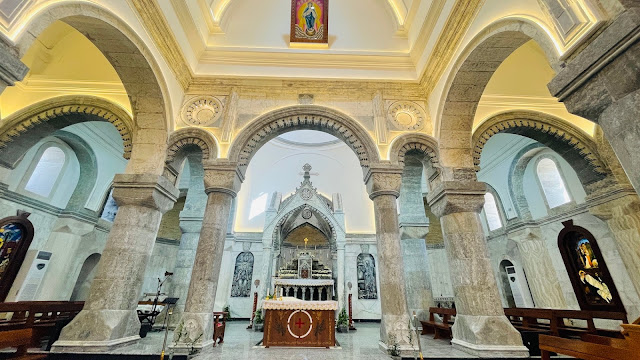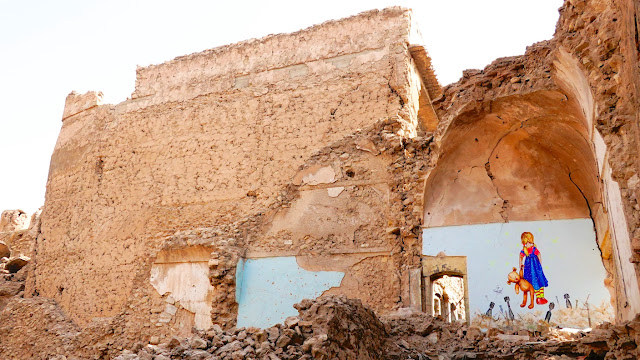In this post we visit the city of Mosul and then drive to Bakhdida Town (Qaraqosh) and on to Erbil.
QUICKIE: according to our two guides, the body of Saddam Hussein was removed from his new grave in his home town of Kirkuk and re-buried in a secret spot just days before civilians destroyed his original grave.
Mosul (Pop 3.7m, Elev 223m) is Iraq’s second largest city and the first to be captured by ISIS with 60% of it destroyed by the time the conflict was over. Mosul is approximately 400 km (250 mi) north of Baghdad on the Tigris river. Mosul and its surroundings have an ethnically and religiously diverse population; a large majority of its population are Arabs, with Assyrians, Turkmens, and Kurds, and other, smaller ethnic minorities comprising the rest of the city's population. Sunni Islam is the largest religion, but there are a significant number of Christians. Mosul is considered to be among the larger and more historically and culturally significant cities of the Arab World. Due to Mosul's strategic location it has traditionally serving as a hub of international commerce and travel. Products of the area include Mosul marble and oil. Mosul is home to the University of Mosul and its renowned Medical College, one of the largest educational and research centres in the Middle East. Like most cities in the Iraq, Mosul was occupied by several empires and founded by the Assyrians as early as 2352BC.
We visited the following places in Mosul: The Old Town, Al-Nuri Mosque, Al Tahira Catholic Church, Syriac Orthodox Church, Bash Tapia Castle, Kubba of Mosul Area.
The Old Town was mostly destroyed by ISIS. We walked around to see devastated houses, mosques and churches. Some of the houses still had unclaimed dead bodies in them according to our local guy who showed us around.
The Great Mosque of al-Nuri was famous for its leaning minaret, which gave the city its nickname "the hunchback". Tradition holds that the mosque was first built in the late 12th century, although it underwent many renovations over the years. The mosque withstood various hostile invading forces over its 850-year history until it was destroyed by ISIL, along with its distinctive minaret, in the Battle of Mosul in 2017. UNESCO is now funding a complete reconstruction of the mosque starting with assembling the original marble stonework and then adding what cannot be restored. The project is due for completion in 2026.
The al-Tāhirā Syriac-Catholic church of the Immaculate Conception of Mosul was restored in 1744 after several conflicts damaged it and its foundations date back to the 7th Century. It is located in the oldest part of the Old Town and being rebuilt piece by piece like the Al-Nuri Mosque. On 7 March 2021, Pope Francis visited the demolished Church and also visited many sites in Mosul. The Papal visit to Iraq 5-8 March 2021 was historic and the only one and the Pope also met with the leaders of the Shia and Sunni faiths.
The Bash Tapia Castle was built in the 12th Century AD and played an important role in the siege of Mosul during the Ottoman–Persian War of 1743–46. For many centuries the castle was a landmark and a symbol of Mosul's identity and has commanding views of the city and the Tigris River. in 2014, ISIL decided to destroy it using a drone of all things. Not much is left standing but there is an application with UNESCO to restore it.
We all then circled back to the Al-Nuri Mosque where we sat outdoors and lunched on the Mosul specialty called KUBBA – a plate shaped and sized boiled semolina pita with minced lamb and finely diced onion. It has a soft silk touch and quite tasty but you cannot eat a lot as the semolina quickly fills you up. I also tried pickled cauliflower in pita another Mosul treat – quite vinegary and a little bland – looks better than it tastes. Everything is pickled in Mosul !!!
The town of Bakhdida (Qaraqosh) is close to Mosul and on the way to Erbil. It is famous for the Catholic Church of the Immaculate Conception which Pope Francis visited on 7 March 2021 and held a mass to commemorate the people of Iraq who died at the hands of ISIS. We were met by Fr Amar who showed us around the new church restored just in time for the Popes visit after it was totally incinerated by ISIS in 2014 and originally built in 1932. We saw the Pope’s gift to the Church and Town – a Greek silver-gilded icon of the Virgin Mary with Her Son. We also saw a cornet of the burnt church held in memorium and the courtyard outside where the Pope blessed the masses.
Erbil is only 66km away from Bakhdida but at 43km from Erbil you pass through the unofficial border of Kurdistan. Our driver and guides took our passports in to show (not stamp) and they have to obtain a temporary residency certificate that lasts one month. The shock came when our leader told us that it would take at least 2hrs for our Iraqis to get their permits so she organised four taxis to take us to Erbil – a great gesture that achieved the earliest arrival at a hotel so far – 4pm. You know what this meant – a run !!! I was so pleased to get a run in today that I ran 12km – it was warm and the sun set during the run exposing me to the crazy peak hour traffic of Erbil. I managed to get it done but was buggered after but happy. I had time to stock up on wine and even found a hot BBQ chicken – had a feast that night along with a full movie – so good to get this extra time off.
Enjoy our last day in mainstream Iraq and get set for the next five days seeing the wonders of Kurdistan…






















No comments:
Post a Comment